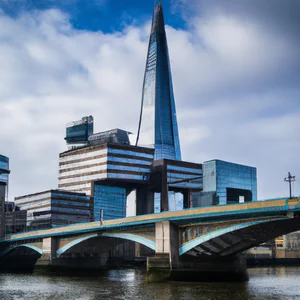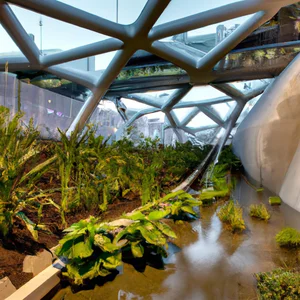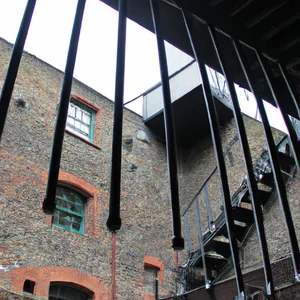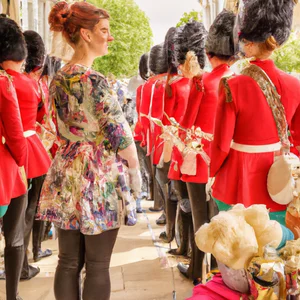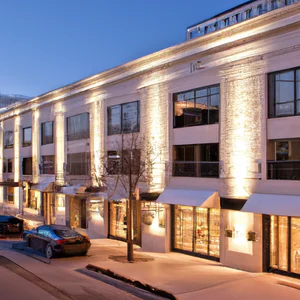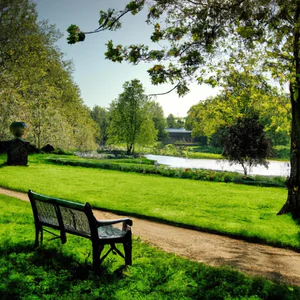Book your experience
St John's Wood: elegant villas, Abbey Road and cricket at Lord's
St John’s Wood is a place that has a certain charm, you know? It’s like a corner of London where everything seems a little more chic. The villas there are really elegant, they look like they came out of a film, with well-kept gardens and architecture that make you think of a bygone era. I remember once, while I was walking, I saw a house with huge windows – truly an eye-catcher!
And then there is Abbey Road, which is not just a road, but a bit of an icon. Who hasn’t dreamed of crossing it like the Beatles? Every time I pass by there, it makes me smile, imagining the stories that took place in that place. It is a destination for tourists, of course, but also for those who, like me, have a passion for music. I even took a photo with the famous pedestrian crossing, but, I tell you, it took me a while to find the right moment without someone being in the way!
And let’s not forget the cricket at Lord’s. Oh, that’s where you can breathe an air of tradition! I’m not a great expert, in fact, cricket for me is a bit like trying to decipher an Arabic novel. But it fascinates me to see how fans gather to enjoy the matches, with their shirts and the time passing slowly. I remember once, a friend took me to see a match, and while everyone was glued to the pitch, I was trying to understand what was happening… and in the end, I ended up enjoying the atmosphere more than the game itself!
In short, St John’s Wood is a place that mixes elegance and a pinch of history, with a touch of music and sport. It’s like a perfect cocktail, for those who love to immerse themselves in a bit of everything. I don’t know, maybe it’s a place to come back to, don’t you think?
Elegant villas: a tour of historic architecture
An enchanting experience
I vividly remember the first day I set foot in St John’s Wood. As I strolled along the quiet streets, surrounded by elegant villas and well-tended gardens, I felt as if I had stepped into a painting. The red brick facades, characteristic gables and elegant wrought iron gates tell stories of a bygone era. It was at that moment that I realized how fascinating the historic architecture of this neighborhood was, a true hidden treasure of London.
A tour not to be missed
St John’s Wood, located just a stone’s throw from the beating heart of London, is famous for its Victorian and Georgian villas. For an in-depth tour, I recommend starting from Abbey Road and then heading towards Hamilton Terrace and Wellington Road, where you can admire some of the most fascinating residences in the area. Many of these villas boast interesting histories: for example, Sir Paul McCartney’s house is located right here, immersed in the context of a neighborhood that has seen generations of artists and intellectuals pass by.
An insider tip
If you want a truly unique experience, consider visiting Regent’s Park right next to St John’s Wood. Here you can not only enjoy a picnic among the flower beds, but also admire the villas from a different perspective. Many visitors do not know that there are hidden paths that offer incredible panoramic views and which are often little frequented.
The cultural impact
The historic architecture of St John’s Wood is not only a feast for the eyes, but also an important part of London’s cultural history. This neighborhood has served as a haven for artists, musicians and writers over the centuries, helping to shape the city’s cultural identity. The villas, in particular, reflect social change and the aspirations of a growing class during the 19th century.
Sustainable tourism
If you are passionate about sustainable practices, know that some of the villa owners in St John’s Wood have started to renovate their homes using eco-friendly materials and sustainable construction techniques. Taking tours that promote architectural history and sustainability is a great way to appreciate the beauty of the neighborhood while supporting an important cause.
Soak up the atmosphere
Walking among these villas, let yourself be enveloped by the tranquility and beauty of the place. Imagine the stories these walls could tell, the laughter and love that took place among the manicured gardens and elegant rooms. Every corner, every window is an invitation to explore the lives of those who lived here before us.
An unmissable activity
Don’t forget to visit Lord’s Cricket Ground, just a short walk from St John’s Wood, for a guided tour. Even if you’re not a cricket fan, discovering the history of this legendary stadium will give you a further appreciation for the cultural importance of this corner of London.
Myths to dispel
A common misconception is that St John’s Wood is only for the rich and famous. While the neighborhood is home to some of London’s most expensive properties, it’s also a place accessible to all, with public spaces and activities to enjoy that allow you to experience the area without having to spend a fortune.
A final reflection
As you close your eyes and imagine the beauty of St John’s Wood, I invite you to reflect on how each villa tells a story, and how each of us has the power to write our own chapter in this fascinating book of historic architecture. What story would you like to discover or tell in this wonderful corner of London?
Walk on Abbey Road: the myth of the Beatles
A step into the myth
I vividly remember the moment I set foot on Abbey Road, the fateful crossing immortalized on the Beatles album cover. The crowds of tourists crowding around the famous zebra crossing were almost palpable, and the atmosphere was filled with an infectious energy. Each person seemed to share a moment of connection, not only with the history of music, but also with an era of innovation and rebellion. Walking on that white stripe, hearing the click of the camera and the echo of the Beatles melodies in my mind, was an experience I will never forget.
Practical information
Abbey Road is located in the St John’s Wood district, easily accessible by tube (St John’s Wood station). The street is open to the public and there is no entrance fee, but it is advisable to visit during off-peak hours to avoid crowds. To delve deeper into the history, nearby Abbey Road Studios offers guided tours, but it’s essential to book in advance as places are limited. More information can be found on the official Abbey Road Studios website.
An insider tip
If you want to take a photo without the usual crowds, I recommend visiting Abbey Road at sunrise. The morning lights create a magical atmosphere and, with a bit of luck, you might even find the street completely deserted for your perfect shot. This is a trick that few know and which makes the experience even more special.
Cultural impact
Abbey Road is not just a place; it is a symbol of the musical culture of the 60s. The album “Abbey Road” marked the end of an era for the Beatles and influenced a generation of musicians. The crosswalk has become a pilgrimage for fans around the world, a tribute to a group that changed pop music forever. Today, Abbey Road is a crossroads of cultures, where different generations come together to celebrate the creative genius of the Beatles.
Sustainability in tourism
In the context of responsible tourism, it is important to respect the surrounding area by keeping the environment clean and limiting the use of plastic. Many local tour operators are now promoting eco-friendly experiences, encouraging visitors to use public transport or bicycles to explore the area.
An experience worth trying
After yours walk along Abbey Road, don’t miss the opportunity to visit the nearby John Lennon Memorial, a green area dedicated to the musician’s memory. Here you can sit, reflect and maybe even sing one of his most famous songs. A simple and profound way to connect with history.
Myths to dispel
A common misconception is that Abbey Road is the only Beatles-related site in London. In fact, the city is dotted with significant places for fans, such as the famous pub “The Cavern Club” and the legendary “Apple Corps”. Don’t limit yourself to just one location; explore and discover the Beatles’ legacy across the capital.
A final reflection
As you leave Abbey Road, we invite you to reflect on how music can bring people together, regardless of where they come from. What is your favorite Beatles song and what does it represent for you? The next time you find yourself in this iconic place, take a moment to appreciate not only the music, but also the power it has to create bonds between generations.
Lord’s Cricket Ground: the essence of British cricket
An unforgettable experience
I still remember the first time I set foot at Lord’s Cricket Ground, a place that exudes history and passion. As I approached the famous stadium, the smell of fresh grass and the sound of batsmen hitting the ball immediately enveloped me. That day, I witnessed a cricket match that not only showcased the extraordinary skills of the athletes but also told an age-old story of tradition and competition.
Practical information
Lord’s, founded in 1787, is known as ’the home of cricket’ and is located in the heart of St John’s Wood, just a short walk from the tube station. Today, the field hosts not only international matches, but also guided tours that allow you to explore the history and architecture of the place. Visits include access to the Cricket Museum, where you can admire historic trophies and iconic objects. Tickets can be purchased online at the official Lord’s Cricket Ground website, and I recommend booking in advance, especially during the summer season.
An insider tip
A secret that only true enthusiasts know is the “MCC Museum’s Collection”. This museum is not only a place to admire trophies, but also to explore rare and historic cricket-related objects, such as Sir Donald Bradman’s famous leather bag. If you are a cricket lover, be sure to ask your guide to show you these hidden treasures.
The cultural impact
Lord’s is not just a playground; it is a symbol of British identity. Cricket, a traditional sport, has deep roots in UK culture, and Lord’s plays a central role in this tale. Every match played here is an event that brings together families, friends and fans, contributing to a sense of community that goes beyond simple sport.
Responsible tourism practices
When visiting Lord’s, consider using public transportation to reduce your environmental impact. The subway and local buses are excellent options for reaching the camp, and in this way you help preserve the beauty of the surrounding area.
Engaging atmosphere
Imagine sitting in the wooden stands, sipping a local beer as the sun illuminates the bright green field. The fans sing chants, the atmosphere is full of emotions, and every hit by the batsman is greeted by a roar of enthusiasm. Here, history intertwines with the present, creating an experience that will make you feel part of something much bigger.
An activity not to be missed
If you have the opportunity, take part in one of the “Test Match” days. These matches can last up to five days and offer a unique experience, allowing you to fully immerse yourself in the atmosphere of British cricket. Don’t forget to bring a picnic and enjoy your meal while watching the game.
Myths to dispel
Many think that cricket is a boring game, but in reality it is a fascinating combination of strategy, skill and adrenaline. Each match tells a story of competition and skill, capable of keeping spectators glued for hours.
Final reflection
As you leave Lord’s, ask yourself: What is your favorite sport and how does it impact your daily life? In a fast-paced world, immersing yourself in the history and culture of a place like this could give you a new perspective on what it means to belong to a community.
Discover hidden gardens: green oases in St John’s Wood
A personal experience
During my walk in St John’s Wood, I came across a small hidden garden, surrounded by tall box hedges and seasonal flowers. The sunlight filtered through the foliage, creating a play of shadows that seemed almost magical. Sitting on a wooden bench, I listened to the birds singing and the leaves rustling, a moment of pure serenity in one of the liveliest areas of London. That discovery was one of the most beautiful experiences I had in the city, a reminder of how full of surprises even a simple walk can be.
Practical information
St John’s Wood is known not only for its historic architecture and tranquil atmosphere, but also for its secret gardens. Some of the best known include the Jewel Tower Garden and the Paddington Street Gardens. These green spaces are open to the public and offer an ideal retreat for those seeking a moment of relaxation away from the urban bustle. For up-to-date information on opening times and special events, you can consult the official Westminster City Council or Royal Parks websites.
Unconventional advice
If you want to discover a truly unique garden, visit the Garden Museum. Located in an old monastery, this museum not only displays a fascinating collection on the history of gardens in Britain, but also features a garden that changes with the seasons. An insider would recommend that you attend one of the gardening workshops that are often organised, where you can learn practical techniques in a stimulating environment.
Cultural and historical impact
St John’s Wood Gardens are not just green spaces; they are a reflection of the social and cultural history of the neighborhood. Originally a holiday area for the aristocracy in the 17th century, the gardens have retained their importance over the centuries, becoming meeting and relaxation places for the local community. These green spaces have helped keep alive the tradition of gardening, a fundamental aspect of British culture.
Sustainability in tourism
Many of the gardens in St John’s Wood are adopting sustainable gardening practices, such as the use of native plants and composting techniques. Participating in community gardening events will not only allow you to contribute to these efforts, but will also give you the opportunity to meet local residents and learn more about the flora and fauna of the area.
Atmosphere of the place
Imagine walking along flower-filled paths, surrounded by centuries-old trees that tell stories of bygone eras. The air is filled with a delicate scent of flowers and fresh grass, while the sound of flowing water in a small fountain adds a touch of serenity. Each garden has its own personality, from formal to wild, and each is worth exploring.
An activity worth trying
I recommend spending an afternoon visiting Regent’s Park Gardens, which are just a short walk away. Here you can take part in a guided tour, where gardening experts will take you to explore the rare plants and flower gardens. Don’t forget to bring your camera - there are unforgettable photo opportunities infinite!
Myths and misconceptions
A common misconception is that gardens in London are always crowded and not very accessible. In fact, many gardens in St John’s Wood offer peaceful spaces where you can retreat and enjoy nature, even in the middle of the city. The key is knowing where to look.
Final reflection
As you plan your visit to St John’s Wood, ask yourself: which garden could tell your story? With so many hidden green spaces, every corner has something to offer. Be amazed by the beauty that lies behind every hedge and discover the London that few tourists get to see.
Local cafes: Enjoy coffee like a Londoner
A personal experience between the cups
I still remember my first visit to a small cafe in St John’s Wood, ‘The Coffee House’, a modest but welcoming corner. While I sipped a latte macchiato prepared with coffee beans of Ethiopian origin, the enveloping scent and sound of the coffee machines transported me to a world of aromas and flavors. The barista, an avid coffee connoisseur, told me the story behind each cup, making my stay not just a break, but a sensory experience.
Practical information on local cafes
St John’s Wood is a true mecca for coffee lovers, with a variety of coffee shops offering unique experiences. Some of the most renowned places include “The Coffee Works Project” and “Café Laville”, both known for their attention to bean quality and artisanal brewing techniques. Don’t forget to ask about their extraction methods, which range from classic espresso to the latest cold brew. You can find further information on events and tastings directly on their Instagram profiles.
An insider tip
If you want to enjoy coffee like a Londoner, try visiting one of these coffee shops during peak morning hours. Not only will you have the opportunity to observe the daily lives of the residents, but you may also come across a variety of specialty coffees that are only offered at that time. Some bartenders reserve surprises for those willing to experiment.
The cultural impact of coffee in London
Coffee has played a vital role in London’s social life, especially in recent years, with the growing popularity of independent coffee shops. These spaces are not just places to have a drink, but real cultural hubs where conversations, art and community intertwine. The café culture in St John’s Wood reflects a balance between the traditional and the contemporary, creating a lively and welcoming atmosphere.
Sustainable tourism practices
Many local cafes are committed to sustainable practices, using eco-friendly coffee beans and promoting fair trade. Opting for coffee from these sources not only supports producers, but also contributes to more responsible and conscious tourism.
An experience worth trying
Don’t miss the chance to attend a coffee making workshop at one of the local cafes. These experiences will allow you to learn extraction techniques and refine your palate, making your stay in St John’s Wood even more memorable.
Myths and misconceptions about coffee in London
A common misconception is that coffee in London is of poor quality. In reality, the coffee scene is constantly evolving and many baristas are passionate about their craft, investing time and resources in sourcing the best beans and perfecting preparation techniques.
Final reflection
Next time you’re in St John’s Wood, take the time to explore the local cafes. What is your favorite way to enjoy a cup of coffee? Perhaps you will discover that every sip is a journey through the stories, cultures and passions that make London a fascinating and unique place.
St John’s Wood: a corner of tranquility in the capital
A personal experience
I remember the first time I set foot in St John’s Wood; it was a spring morning and the air was crisp. As I strolled along the tree-lined streets, I came across a small park, hidden among the elegant Victorian villas. There, I found a group of residents gathering for an outdoor yoga session. The serenity of that moment, with the birds singing in the background, made me understand how this neighborhood can represent a refuge from the hustle and bustle of London.
Practical information
St John’s Wood is easily accessible via the tube, with the St John’s Wood stop on the Jubilee Line. This neighborhood, known for its charming architecture and quiet streets, is also home to some of the capital’s best cafes and restaurants. According to Time Out London, the area is constantly evolving, with new openings enriching the gastronomic and cultural offer.
An insider tip
A little-known tip is to visit Regent’s Park early in the morning, when the crowds are still far away. Here, you can enjoy a solitary stroll through the gardens and admire Queen Mary’s Rose Garden, a botanical wonder that blooms in myriad colors throughout the spring and summer. This corner of tranquility is the perfect way to start the day before exploring the wonders of St John’s Wood.
Cultural and historical impact
Once a rural village, St John’s Wood has retained its historic charm, contributing to London culture with events and art galleries. The area is also famous for its vibrant arts community and for having hosted numerous musicians and writers over the years, making it a crossroads of creativity and innovation.
Sustainable tourism practices
If you’re looking for a way to make your visit more sustainable, consider renting a bike. Several local companies offer bike-sharing services that will allow you to explore St John’s Wood and its parks without polluting. This approach is not only eco-friendly, but also gives you the freedom to discover hidden corners that you might miss on foot.
An atmosphere to experience
Walking through the streets of St John’s Wood, you will feel surrounded by an atmosphere of calm and tranquility. The elegant villas, with their manicured gardens, tell stories of a fascinating past, while the trees lining the pavements offer shelter from the sun, creating a welcoming and relaxed environment.
An activity worth trying
Don’t miss the opportunity to visit the Lord’s Cricket Ground, which is not just a cricket field, but a real museum dedicated to the history of this sport. You can book a guided tour that will take you through the most significant moments of British sporting culture.
Myths and misconceptions
A common misconception is that St John’s Wood is exclusively for high class tourists. In fact, the neighborhood is a vibrant mix of local residents and visitors, making it accessible to all. The variety of cafes and restaurants offers something for every budget, proving that even the poshest places can be welcoming and inclusive.
A personal reflection
The tranquility of St John’s Wood made me reflect on how important it is to find spaces of calm in the frenzy of modern life. I invite you to consider: What are the places in your life that offer you refuge? And how can you carry some of that serenity with you, wherever you go?
Historical curiosity: St John’s Wood’s village past
A journey through time
I vividly remember my first walk in St John’s Wood, a corner of London enveloped in an atmosphere that seems almost suspended in time. While walking through the tree-lined streets, I came across a small tavern with exposed wooden beams and a sign that told stories of times gone by. This corner of tranquility, once a rural village, has retained its historic charm despite the rapid urbanization that has characterized London.
A fascinating past
St John’s Wood has origins dating back to the 14th century, when it was a simple village surrounded by woodland and farmland. With the arrival of the railroad in 1860, its transformation into an elegant residential neighborhood was unstoppable. The presence of historic architecture such as Victorian villas and Gothic churches still testifies to its past today, making it a fascinating place to explore.
- St. John’s Wood Church: This church, built in 1814, is a perfect example of the neoclassical style. It is a landmark that tells the story of the local community.
Insider tip
A little-known tip for visitors to St John’s Wood is to explore the secrets hidden within its private gardens. Some of these historic gardens, open to the public only for special events, offer a unique opportunity to immerse yourself in the beauty of nature and architecture. Check the St John’s Wood Society events calendar to find out when openings are held.
The cultural impact
This neighborhood not only has a rich history, but has also influenced London’s cultural landscape. It has been the place of residence of numerous artists and writers, including the well-known painter John Constable. Its cultural heritage is palpable, making St John’s Wood an area of great relevance for visitors interested in the capital’s artistic and literary history.
Sustainability and responsibility
In an age where sustainability is key, St John’s Wood is playing its part. Several local initiatives promote environmental conservation, such as farmers’ markets offering local and organic products. Choosing to buy here means supporting the local economy and contributing to more responsible tourism.
Immerse yourself in the atmosphere
For an unforgettable experience, I recommend spending an afternoon exploring the gardens of St John’s Wood, such as the famous Lord’s Cricket Ground, which is not only a place for cricket lovers, but also an oasis of tranquility in the close to the frenzy of London. Don’t forget to bring a good book and a thermos of tea with you!
Myths and misconceptions
St John’s Wood is often thought to be just a residential area for the wealthy, but in reality it has much more to offer. Its historical roots and commitment to the community make it an accessible and fascinating place for everyone, not just those with high purchasing power.
Final reflection
As you stroll the streets of St John’s Wood, I invite you to reflect on the beauty of the history that permeates every corner. What stories do the ancient villas and well-kept gardens tell? Next time you find yourself in this corner of London, ask yourself how the past has shaped the present and what the future holds.
Sustainability in tourism: eco-friendly experiences to try
Imagine finding yourself in a corner of London where the past and the future harmoniously intertwine, and where sustainability is not just a buzzword, but a daily practice. On a recent visit to St John’s Wood, I found myself sipping delicious organic tea in a local cafe, surrounded by lush plants and decorations made from recycled materials. This small corner of eco-sustainability is just one example of the many initiatives present in this fascinating neighborhood.
Eco-friendly choices for responsible tourism
St John’s Wood offers numerous ways to explore the neighborhood in a sustainable way. Here are some practical options:
Eco-conscious cafes and restaurants: Many area cafes, like The Green Room, use locally sourced ingredients and waste-reducing practices. Here, you can enjoy dishes prepared with fresh vegetables from local farmers, all served in compostable containers.
Walking or cycling: Exploring St John’s Wood on foot allows you not only to immerse yourself in the architectural beauty of its Victorian villas, but also to discover hidden corners and secret gardens. The well-maintained cycle paths make cycling an ideal alternative for getting around without polluting.
Volunteer Activities: Participating in park cleanup or community gardening projects is a great way to immerse yourself in local culture and contribute to the environmental well-being of your neighborhood.
Unconventional advice
If you want an authentic experience, I recommend visiting the St John’s Wood Community Centre, where sustainability events are often held, including workshops on how to reduce your environmental impact. Here, you’ll have the opportunity to meet local residents who are passionate about eco-friendly practices, and perhaps you’ll even go home with some helpful advice to apply yourself.
The cultural impact of sustainability
The focus on sustainability in St John’s Wood is not just a trend; it is part of a larger movement that recognizes the importance of preserving our environment. This neighborhood, with its rich history and traditions, is becoming a model of how communities can evolve without sacrificing their cultural heritage. Local initiatives are helping to raise visitor awareness of the importance of traveling responsibly and protecting our planet.
An experience not to be missed
Don’t miss the chance to join one of the guided tours organized by EcoExplorer, which will take you through St John’s Wood and show you how the community is tackling environmental challenges. These tours offer a great opportunity to learn the stories of those who live and work here, while enjoying the beauty of the neighborhood.
Final reflection
Sustainable tourism is often thought to be about sacrifice, but in St John’s Wood you will find that it is possible to enjoy rich and rewarding experiences without compromising our environment. The real question is: how can we all help make tourism more sustainable in our future adventures?
Cultural events: festivals and events not to be missed
When I first set foot in St John’s Wood, I didn’t expect to stumble upon a vibrant arts and culture festival taking place right in the heart of the neighbourhood. It was a sunny Sunday and the streets were alive with street artists, musicians and stalls offering culinary delicacies from all over the world. I breathed an air of creativity and passion that immediately captured me.
A calendar full of events
St John’s Wood is not just a place of architectural elegance and history; it is also an epicenter of cultural events that attract visitors from all over London. Every year, festivals such as St John’s Wood Art Festival take place, where local artists exhibit their work in pop-up galleries and public spaces. During the festival, you can also participate in creative workshops, listen to lectures and, why not, try painting under the guidance of an expert artist.
Also, don’t miss Regent’s Park Open Air Theatre, located a short walk from St John’s Wood. With shows ranging from classics to contemporary productions, it’s an experience to be had under London’s starry skies.
An insider tip
If you’re in the area during August, don’t miss the London Festival of Architecture. Although mainly held in other areas of the capital, there are side events in St John’s Wood offering guided tours of the historic villas and wonders architecture of the neighborhood. It’s a perfect opportunity to discover the history of the place through a new lens.
The cultural impact of these events
Cultural events not only enrich St John’s Wood’s offerings, but also help to strengthen the sense of community. These events are a platform for local artists and a way for residents to connect with their neighborhood and visitors. The active participation of the community makes each festival unique and memorable.
Sustainability and responsibility
Many events in St John’s Wood promote sustainable practices, such as the use of recyclable materials and promoting locally sourced food. By choosing to participate in these festivals, you not only enjoy a cultural experience, but you also support eco-friendly initiatives that aim to preserve the beauty and authenticity of the neighborhood.
Soak up the atmosphere
Imagine walking through the streets of St John’s Wood during one of these events, surrounded by colors and sounds that bring the scene to life. The scents of street food mix with the visual art that surrounds you, creating a lively and engaging atmosphere. It’s a moment to live, not just observe.
An experience worth trying
If you are an art lover, I recommend attending a workshop during one of the festivals. Not only will you learn something new, but you will also have the opportunity to meet artists and residents, creating lasting bonds and memories.
Myths and misconceptions
A common misconception is that cultural events in St John’s Wood are for tourists only. Instead, the local community actively participates and events are designed to be inclusive and accessible to all. So, don’t hesitate to join the party!
Final reflection
St John’s Wood is not just a postcard of elegance and history, but a stage for cultural experiences just waiting to be discovered. Have you ever wondered what story the next festival could tell you?
A unique tip: explore hidden art galleries
My first visit to St John’s Wood was marked by an experience that changed the way I viewed contemporary art. Walking along the quiet streets, I discovered a small gallery called The Zabludowicz Collection, hidden in a former warehouse. The atmosphere was magnetic, with provocative works that challenged convention and emerging artists telling stories of life and culture. This secret corner has opened the doors to a world of creativity that is rarely mentioned in tourist guides.
Discover hidden gems
St John’s Wood art galleries offer a unique opportunity to explore art in a more intimate setting than crowded museums. Many of these galleries, such as Lisson Gallery and The Camden Arts Centre, are free and host temporary exhibitions by local and international artists. According to the official Visit London website, these galleries not only exhibit artwork, but often organize events and workshops that engage the community, making art accessible to all.
An insider advises
A little-known tip is to visit galleries during private event openings, where you will have the opportunity to meet the artists and hear their narratives straight from their lips. It’s a more personal and engaging experience than a standard visit. Plus, many galleries offer free refreshments during these events, making the evening even more enjoyable!
Cultural impact
Art has always played a crucial role in the history of St John’s Wood. This neighborhood, known for its bourgeois charm, has been a haven for artists and intellectuals since the Victorian era. The presence of contemporary art galleries helps to keep this tradition alive, making St John’s Wood a constantly evolving cultural reference point.
Sustainability and responsibility
In an age where sustainable tourism is increasingly important, many galleries in St John’s Wood are committed to reducing their environmental impact. Some of them participate in initiatives that promote the use of recycled materials and the organization of eco-friendly events. Choosing to visit local art galleries is also a way to support the area’s creative economy, contributing to more responsible tourism.
Immersion in the atmosphere
Imagine walking along the narrow streets of St John’s Wood, surrounded by elegant Victorian villas and ancient trees, as art reveals itself in unexpected corners. Each gallery tells a unique story, inviting you to reflect and experience different emotions. The atmosphere is vibrant, yet intimate, a perfect balance between the frenetic pace of metropolitan life and the serenity of the neighborhood.
An experience not to be missed
Don’t miss the opportunity to participate in an art gallery tour organized by expert guides, who can offer historical and cultural insights that will enrich your experience. Some tours also include wine tastings or aperitifs at local bars, making the evening even more memorable.
Addressing the myths
A common misconception is that art galleries are only for experts or collectors. In fact, many galleries are open to all and seek to engage the public with events and activities that make art accessible and fun. You don’t need to be an expert to appreciate the beauty and creativity expressed in the works.
Final reflection
Next time you’re in St John’s Wood, ask yourself: how many hidden stories lie behind each work of art? Exploring art galleries is an opportunity to see the world from a new perspective and discover cultural riches that London has to offer. You may discover a corner of creativity that will change the way you see art and life itself.

 Architecture and Design
Architecture and Design Cities and Regions
Cities and Regions Culture and History
Culture and History Events and Festivals
Events and Festivals Fashion and Shopping
Fashion and Shopping Food and Wine
Food and Wine Nature and Adventure
Nature and Adventure Unique Experiences
Unique Experiences


















